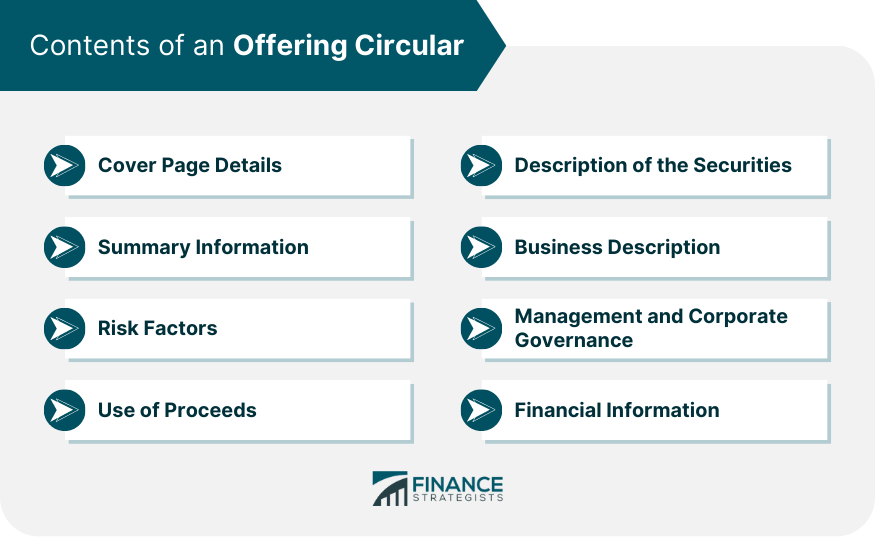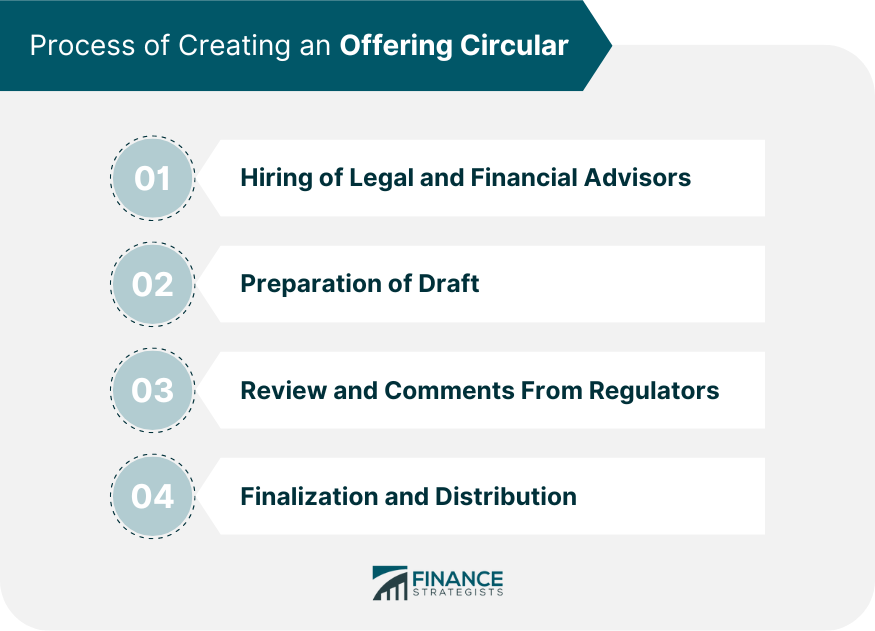An Offering Circular is a legal document that a company creates when it plans to issue securities, such as shares or bonds, to potential investors. It includes comprehensive information about the company, the securities being offered, the management team, and financial information, among other details. The purpose of an offering circular is to provide prospective investors with all the necessary information to make an informed decision about the investment opportunity. It highlights the benefits and risks associated with the investment, how the raised funds will be used, and gives an overview of the company's business and financial health. An offering circular serves as a key communication tool between the company and potential investors, fostering transparency and promoting informed investment decisions. A prospectus, like an offering circular, is a document that provides detailed information about the security offered to the public. However, there are key differences between the two. The prospectus is generally more detailed than an offering circular and is required for larger public offerings, often those that are listed on a stock exchange. An offering circular is generally used for smaller, private offerings and contains less detailed information than a prospectus. The decision to use an offering circular or a prospectus typically depends on the size and nature of the offering, the requirements of the regulatory authorities, and the company's preferences. The cover page typically includes the name of the issuing company, the type and amount of securities being offered, and the offering price. The offering circular provides a summary of the security offering, including the purpose of the offering, the business of the company, and a summary of the risk factors. This section provides a detailed account of the potential risks associated with investing in the securities. These could range from general market risks to specific business risks faced by the company. Here, the company explains how it plans to use the funds raised from the security offering. This could include business expansion, debt repayment, or other corporate purposes. This section provides details about the securities being offered, including rights and privileges, and any restrictions associated with them. A comprehensive description of the issuing company's business, including its history, operations, products or services, and market position, is provided. The offering circular introduces the company's management team and provides information about the corporate governance structures in place. This section includes financial statements and other relevant financial data, giving investors a clear picture of the company's financial health. Companies generally engage legal and financial advisors to guide them through the process and ensure regulatory compliance. The draft is prepared by collating information from various departments within the company and carefully crafting the narrative to communicate the offering details effectively. Once the draft is prepared, it is submitted to the regulatory authorities for review. They may provide comments and suggestions, which are incorporated into the final version. After all corrections and adjustments have been made, the final offering circular is distributed to potential investors. In an initial public offering (IPO), the offering circular helps potential investors understand the company and its offering, assisting them in making informed investment decisions. In the case of debt offerings, such as corporate bonds, the offering circular provides details about the terms of the debt, the company's repayment plan, and the risks associated with the debt. For private placements, an offering circular is an essential tool for communicating with a smaller group of potential investors, often institutional investors. When a company plans to merge with or acquire another company, it might issue securities to finance the transaction. The offering circular provides the necessary details to prospective investors. In an exchange offer, a company offers to exchange its own securities for those of another company. The offering circular provides detailed information about the offer, the company, and the securities. Offering circulars are commonly used in acquisition financing, where a company issues securities to raise funds for an acquisition. Offering circulars, like all securities-related documents, are subject to strict legal and regulatory controls to ensure transparency and protect investors. In the United States, SEC has regulations governing the content, distribution, and filing of offering circulars. These regulations ensure the accuracy and completeness of the information provided. In other countries, similar financial regulatory bodies oversee the issuance of offering circulars. The specifics of the regulations may vary, but the overarching goal remains investor protection. Offering circulars must adhere to specific disclosure requirements, which vary depending on the jurisdiction and the nature of the securities being offered. Technological advancements are expected to revolutionize how offering circulars are produced and distributed. For instance, artificial intelligence could be used to automate parts of the drafting process, while blockchain technology could enhance security and efficiency in distribution. Regulatory trends will also shape the future of offering circulars. For example, there is a growing emphasis on environmental, social, and governance (ESG) factors, which companies might be required to disclose in their offering circulars. As the world becomes more interconnected, it might see greater harmonization of regulations governing offering circulars across different jurisdictions. This could make it easier for companies to raise capital internationally. An Offering Circular is an essential document in the financial world, providing key insights into a company's operations and the securities it's offering to potential investors. With its comprehensive structure, covering everything from risk factors to financial information, it promotes informed decision-making. Moreover, its role is pivotal in various security offerings and mergers and acquisitions. As technology evolves and regulations shift focus towards areas like environmental, social, and governance factors, offering circulars is set to undergo significant changes. However, they will continue to remain a crucial bridge between companies and investors, fostering transparency and trust. As the financial landscape becomes more interconnected, offering circulars will undoubtedly play an even more vital role in international capital-raising endeavors.What Is an Offering Circular?
Differences Between Offering Circulars and Prospectus
Overview of Prospectus
Key Distinguishing Features
Situations for Use
Structure and Contents of an Offering Circular
Cover Page Details
Summary Information
Risk Factors
Use of Proceeds
Description of the Securities
Business Description
Management and Corporate Governance
Financial Information

Process of Creating an Offering Circular
Hiring of Legal and Financial Advisors
Preparation of Draft
Review and Comments From Regulators
Finalization and Distribution

Role of Offering Circulars in Security Offerings
Initial Public Offerings (IPOs)
Debt Offerings
Private Placements
Role of Offering Circulars in Mergers and Acquisitions
Merger Agreements
Exchange Offers
Acquisition Financing
Legal and Regulatory Aspects of Offering Circulars
Securities and Exchange Commission (SEC) Regulations
Foreign Regulations
Disclosure Requirements
Future of Offering Circulars
Impact of Technology on Production and Distribution
Emerging Trends and Regulations
Predicted Changes
Final Thoughts
Offering Circular FAQs
An offering circular is a legal document prepared by a company planning to issue securities. It provides comprehensive details about the securities, the company, its management, and more. The purpose is to provide potential investors with enough information to make informed investment decisions.
While both provide detailed information about a security offering, the main difference lies in the level of detail and the size of the offering. An offering circular is typically used for smaller, private offerings and contains less detailed information than a prospectus, which is used for larger public offerings that are often listed on a stock exchange.
An offering circular includes several key components: a cover page detailing the name of the issuing company and the specifics of the securities being offered, summary information, risk factors, use of proceeds, description of the securities, business description, management and corporate governance information, and financial information.
An offering circular plays a crucial role in mergers and acquisitions by providing information about merger agreements, exchange offers, and acquisition financing. It allows potential investors to understand the specifics of the deal, the terms of any securities being offered, and the details about the companies involved.
Advancements in technology could streamline the production and distribution of offering circulars. Artificial intelligence could automate parts of the drafting process, and blockchain could enhance distribution security and efficiency. Additionally, emerging regulatory trends, like a greater emphasis on environmental, social, and governance (ESG) factors, might shape the content of future offering circulars.
True Tamplin is a published author, public speaker, CEO of UpDigital, and founder of Finance Strategists.
True is a Certified Educator in Personal Finance (CEPF®), author of The Handy Financial Ratios Guide, a member of the Society for Advancing Business Editing and Writing, contributes to his financial education site, Finance Strategists, and has spoken to various financial communities such as the CFA Institute, as well as university students like his Alma mater, Biola University, where he received a bachelor of science in business and data analytics.
To learn more about True, visit his personal website or view his author profiles on Amazon, Nasdaq and Forbes.















